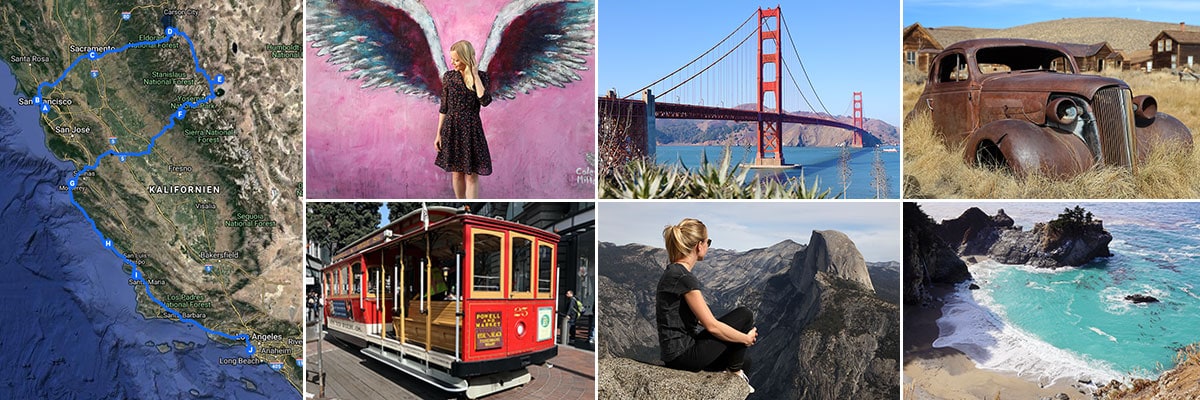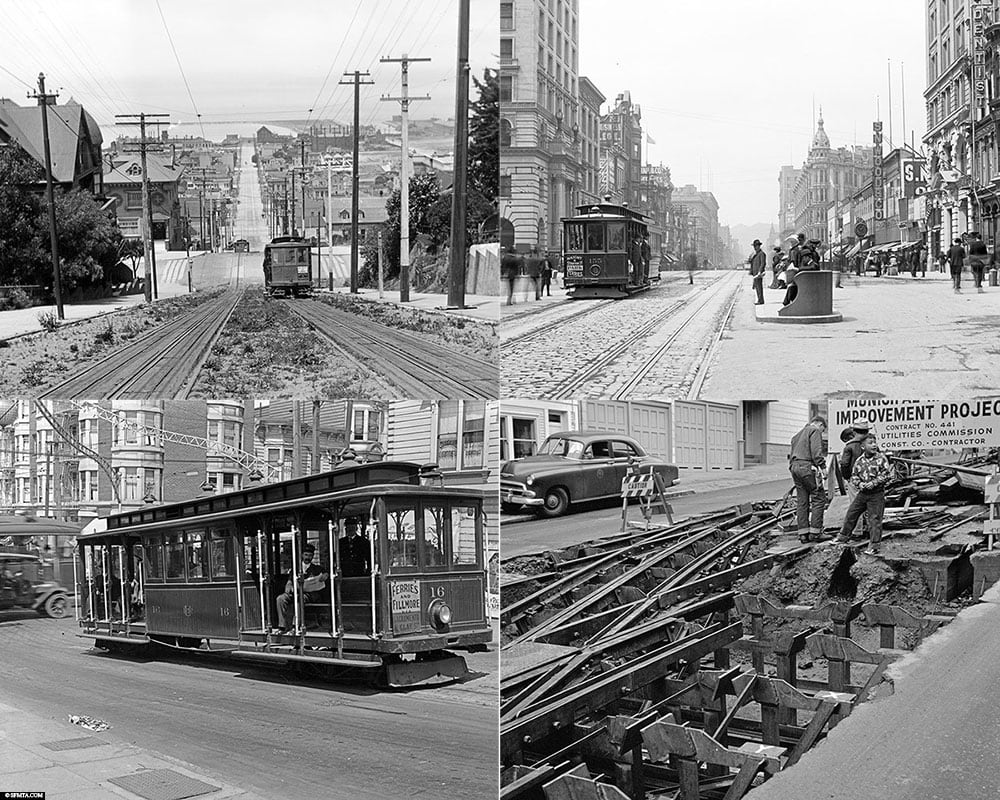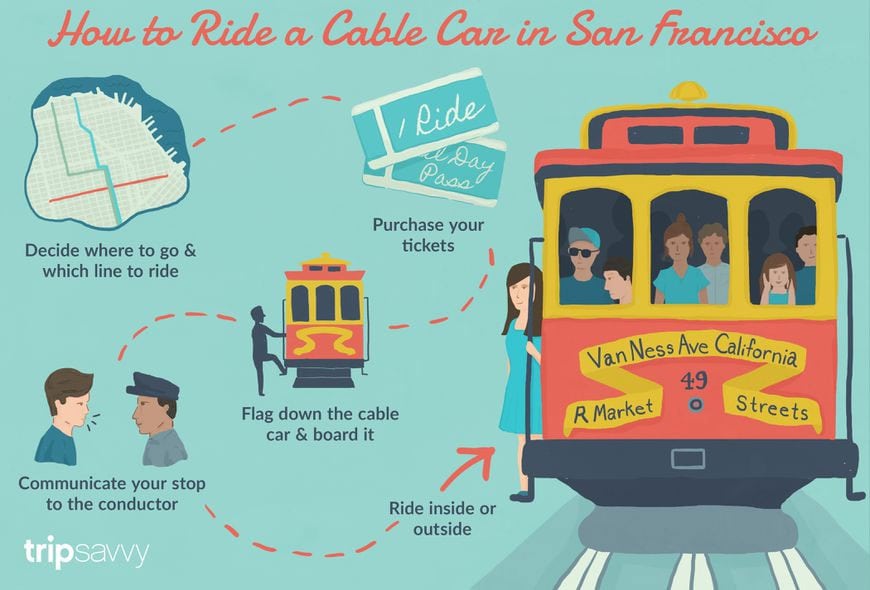In the last few days we have already looked at the most important sights of San Francisco and have really got to know this great city at its best and in bright sunshine. What was missing at the end of our last day was a ride on the legendary Cable Car 🙂

Table of contents
Things to know about the Cable Car
Many of you know San Francisco from movies and know that the streets of the city are sometimes very steep. This is exactly what the legendary Cable Cars were built for, which are the last remaining cable tram in the world with decoupled carriages. The Cable Cars are also the only National Historic Landmark in the United States to travel on the roads.
The history of cable cars in San Francisco
The history of cable cars in San Francisco dates back to the 19th century. Andrew Smith Hallidie, the owner of a wire rope factory, observed a situation in 1869 when a horse-drawn tram slid backwards due to the incredibly heavy load, sadly killing five horses. This experience, as well as his experience in handling wire ropes when pulling wagons in mines, led him to build San Francisco’s first cablecar. Already in 1873 he tested the first cableway system on a small track… and it worked, so that from September 1, 1873, the Clay Street line began to operate. The first line ran on California Street and is the oldest of the active lines still in operation today.
In the years 1877 to 1892 further lines were put into operation. At its peak in the early 20th century, about 600 cars drove through the city at the same time. The interesting thing is that different operating companies have put different routes of the cable cars into operation. Each of the companies had its own network of lines and due to the different construction methods of the wagons and rails, the competing companies could not drive foreign routes at all.
The decline of cable trams
At the turn of the century, several lines of the old cable cars were converted to the new electric tram systems, as they were significantly faster than the old cable cars.
In 1906, the Great Earthquake of San Francisco destroyed almost all lines of the Cable Car. As part of the reconstruction, electric trams were built and used in most places. Only on the steepest stretches of the network did the cable car connections remain. In the 1920s and 1930s, there were also very powerful diesel and trolleybuses, which could also be used on the steep roads, so that they were to gradually replace the cable cars. In 1944, there were only two lines of the Powell Street Line and three lines of the California Cable Car.
A referendum to preserve the remaining cable cars
When the mayor of San Francisco, Roger Lapham, wanted to replace the last urban lines of the cable car with buses in 1947 for cost and safety reasons, the citizen Friedel Klussmann founded the initiative ‘Citizens Committee to Save the Cable Cars‘. With her counter-campaign, she wanted to preserve this historic landmark of San Francisco.
She succeeded in attracting famous and well-known personalities for her cause. And so it happened that their citizens’ association collected more than 50,000 signatures, which ultimately led to a referendum. Friedel Klussmann was right about the result of this referendum: With almost 167,000 votes against about 51,500 votes, the decision was in favour of the Cable Cars, so that the city was obliged to continue the lines. In later years, Friedel Klussmann also championed the Cable Cars by intervening in the planned closure of the line and by agreeing compromises with the city.
In 1964, the Cable Cars were designated a National Historic Landmark and placed under national monument protection. In 1997, in memory of Friedel Klussmann, who died in 1986, the hub at the outer terminal of the Powell-Hyde line was inaugurated as the ‘Friedel Klussmann Memorial Turnaround’.
Repairs & Renewals
In 1978, the cable car lines had to be closed for about seven months because of the urgent need for repairs for about 60 million US dollars. Only 5 years later, all track systems and cable ducts were renewed, the machine house was gutted and equipped with new machines. In addition, 37 Cable Car cars have been restored or rebuilt and put into service.
Since this total refurbishment, there have been several smaller restoration projects to preserve the cable car routes and tracks.
How does a Cable Car actually work?
All the “magic” of the cable cars actually takes place under the streets of San Francisco. Along the various routes, an endlessly circumferential 3 cm thick wire rope runs between the rails in an underground cable channel. In this cable channel, discs, deflection rollers and vertical rollers force the cables at a constant speed into an endless loop, around curves and also over the steep hills of the city. Large, horizontally arranged discs then deflect the cables at the respective end statioenn. Special discs in front of and behind the slopes ensure their length compensation and prevent them from being ripped out of their guide.
The cars themselves do not actually have their own drive. The so-called “Gripman“, which controls the cable cars, grips the moving rope in the cable duct with a clamping claw through a slot in the roadway. The cable car is then pulled at a constant speed of approx. 15 km/h until the driver unplugs the gripper. This happens, for example, when driving downhill. A second person in the rear of the cable car is responsible for braking. It also acts as a conductor as long as the additional braking power is not required. Gripman and Brakeman communicate over two bells while driving. Three independent systems are available for slowing down the cable cars.
On YouTube we found a short video explaining how the technique works in general.
The Cable Car Museum & the Machine House
If you are more interested in the technology of cable cars, you should definitely visit the Cable Cars machine house at the intersection of Mason Street and Washington Street. On the one hand there is a small museum with exhibits and pictures about the history of the cable cars, some cars from the 19th century as well as some exhibits, which explain the technology in more detail.
But the building is not only a museum, but is still the heart of the cable cars. From the museum you have a great view of the large motors that pull the four surrounding ropes through the whole city. For each rope you will find three large wheel wheels, so-called sheaves. The middle one is the drive wheel, in front of it is the circulating wheel, whereby the rope is run around the first so that it is placed on the entire circumference of the drive wheel to maximize friction. If you go down the stairs at the museum entrance, you can see how the ropes are laid below the street.
Admission is the museum is free. The opening hours are from 10 a.m. to 6 p.m. (April to October) and 10 a.m. to 5 p.m. (November to March).
A ride on the Cable Car
What do you have to consider?
If you want to drive a cable car for the first time, you may be unsure what to consider. Which lines are there, where do I buy the tickets, where do I get in and can I stand on the stepping board during the ride? In short: it’s all super simple 🙂
– you do not need a reservation
– you simply choose one of the 3 routes
– you get to one of the final stops or one of the many stopovers
– you can sit down, stand in the aisle or stand on the side footboard
– and the ticket can be purchased before or only on board at the conductor
Operating Hours & Tickets
The operating times of the three Cable Car lines are different. The first cable car of the Powell/Hyde line starts at 6 a.m. in the morning, the last one at 0.20 o’clock in the night. This is similar for the other routes, but also varies a bit on weekdays and weekends. The exact times of each line can be read here: Powell/Hyde Line, Powell/Mason Line, California Line. The frequency also varies, but is usually every 6 to a maximum of 15 minutes.
On the official website of the San Francisco Municipal Transportation Agency (SFMTA) you can find the valid ticket prices. A ride on the Cable Car currently costs 7 US dollars per person. A ticket can be purchased at the final stops or you pay directly on board at the conductor. Another option is the San Francisco CityPASS®, which allows you to use the cable cars for 3 days and also to visit other selected sights free of charge.
Our tip: Instead of a “single ride” for 7 US dollars, you can also buy a “1-Day Visitor Passport” via the APP MuniMobile for just 12 US dollars. With this day ticket you can travel as often as you would like by cable car, all buses, the Muni Metro or the historic tram as you want 🙂
Where is the best place to get in?
Almost 90 of the people at one of the 6 terminus board the cable car. As a result, there are sometimes very long queues forming here, especially at the weekend at the final stop of the Powell/Hyde and Powell/Mason lines on Market Street in Downtown.
Hence our tip: Simply use the intermediate stops of the Cable Car. These are located after almost every block of houses on the routes – in most cases in the middle of the junction or just before the intersection. Sometimes these are a bit hard to find, but usually a small brown sign signals a corresponding stop. And you can climb anywhere. So if you go north just two blocks along Powell Street (direction Union Square) instead of at the final stop on Market Street, the next stop is directly at H&M on the corner of Powell Street and O’Farrell Street. In the cable cars there are always enough seats left, so that you can then easily climb here – and almost always without waiting!
So you don’t always have to walk to one of the final stops.
The 3 different lines of the Cable Car
Of the original 21 lines at the beginning of the 20th century, 3 lines are still in operation in San Francisco. The Powell-Hyde and Powell-Mason lines stretch from Downtown to Fisherman’s Wharf. The California line crosses these two lines and runs west-east through the city. On the following Google map we have drawn the history of the 3 lines:
The Powell Hyde Line (Line 60)
The most popular cable car route in San Francisco is certainly the Powell-Hyde line (line 60). It runs from Market Street in Downtown to the Maritime National Historical Park at Fisherman’s Wharf. The Powell-Hyde line runs north from the final stop at the Powell and Market intersection in downtown San Francisco, past Union Square, and then steeply up Nob Hill. Here it crosses California Street to turn four blocks further sharply to the left into Jackson Street (this is a one-way street to the west, to the east the cars drive on Washington Street). Here we go up again to Hyde Street, where the track turns north again and leads over the Russian Hill steeply down to the coast to the eastern end of Fisherman’s Wharf. [Source: Wikipedia.org]
Where can you get past everywhere on this route?
– at Union Square
– Near Chinatown
– at the Cable Car Museum
– on Lombard Street
– Fisherman’s Wharf (at the western end, Hyde Street Pier)
The special thing about the Powell-Hyde line is the views you have when driving steeply down from Lombard Street towards Fisherman’s Wharf. The route offers great views of the Bay, Alcatraz Prison Island and golden gate bridge on Hyde Street.
The Powell-Mason Line (Line 59)
The Powell-Mason Line (line 59) takes you from Market Street to Pier 45 at Fisherman’s Wharf, where the historic warships USS Pampanito and SS Jeremiah O’Brien are also on display. The Powell-Mason line divides the first section of the line from Market Street to Nob Hill with the Powell-Hyde line. On the hill, however, it already branches off on Mason Street to the north, leading steeply down to Columbus Avenue, which follows it one block wide, and then two more blocks on Taylor Street to the north. The line ends three blocks in front of Pier 43. [Source: Wikipedia.org]
Where can you get past everywhere on this route?
– at Union Square
– Near Chinatown
– at the Cable Car Museum
– North Beach District
– Fisherman’s Wharf (2 blocks from Pier 45)
The California Street Line (Line 61)
The California Street line runs along California Street and therefore from west to east through the city. It is the line least used by tourists. One of the two terminator stations is located on Market Street, almost at the height of the Ferry Building in the Financial District. The California Street line follows California Street along its entire length. The second terminus is on Van Ness Avenue to the west.
Where can you get past everywhere on this route?
– Financial District
– Chinatown
– Nob Hill
– Grace Cathedral
Is it worth a ride on the Cable Car?
Yes, of course! If you’re in San Francisco, a ride on the cable car is just part of it. We had a day ticket and drove all 3 routes in both directions, mostly standing on the footboard. That’s just the most fun 🙂 We can only recommend not only driving the Powell Hyde line used by everyone, but also trying out the California line. There’s less going on here and the line is worth it for a visit to Grace Cathedral.
All travelogues from California (2018)
For our 2 weeks in California we have put together a nice self-drive route, which includes city sightseeing as well as shopping and great nature. Our start is in San Francisco and from there we continue with a rental car to Sacramento and Lake Tahoe. Along the U.S. Highway 395 we drive over the 3,000 meter high Tioga Pass to Yosemite National Park before we head back towards the Pacific coast to Monterey Bay. The last part of the journey takes us along the Pacific Coast Highway (California State Route 1) to Los Angeles. All in all a nice route (see Google Maps) with a total length of about 1.500 kilometers 🙂 » San Francisco: 2 weeks in California – Travel planning & our flight with WOW air
» San Francisco: 2 weeks in California – Travel planning & our flight with WOW air» San Francisco: Tourist Attractions, Things to do & Photo spots
» San Francisco: Golden Gate Bridge in San Francisco – Things to know & Photo spots
» San Francisco: Alcatraz – Our travel guide for the prison island in San Francisco
» San Francisco: Muir Woods – A visit of the Coastal Sequoia Trees in California
» San Francisco: Cable Car – Travel Guide for the famous tram in San Francisco
» Sacramento: Tourist Attractions & Things to do in the Old Town
» Lake Tahoe: Tourist Attractions & the most beautiful photo spots
» Bodie Town: The most beautiful ghost town in California
» Yosemite Nationalpark: Things to know & Tioga Pass
» Yosemite Nationalpark: Mariposa Grove & the Grizzly Giant
» Yosemite Nationalpark: Glacier Point & the Yosemite Valley
» Monterey Bay: Whale Watching with Discovery Whale Watch
» Monterey Bay: The Monterey Bay Aquarium in Cannery Row
» Monterey Bay: 17-Mile Drive – Travel Guide, Things to Do & beautiful photo spots
» Highway 1: The Scenic drive between Monterey and Los Angeles
» Highway 1: Hearst Castle – The castle on the Pacific Coast Highway
» Los Angeles: 3 famous Instagram photo spots in Los Angeles


